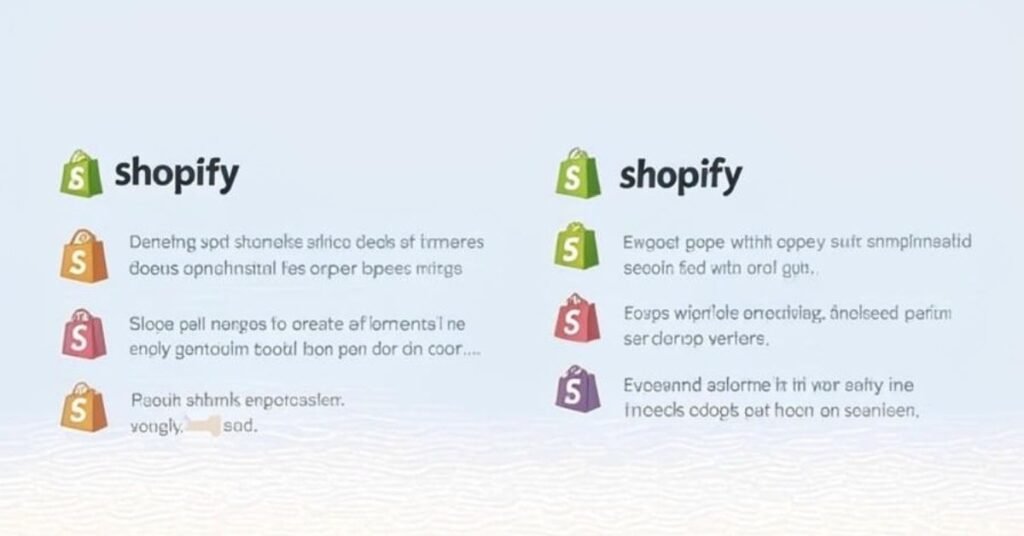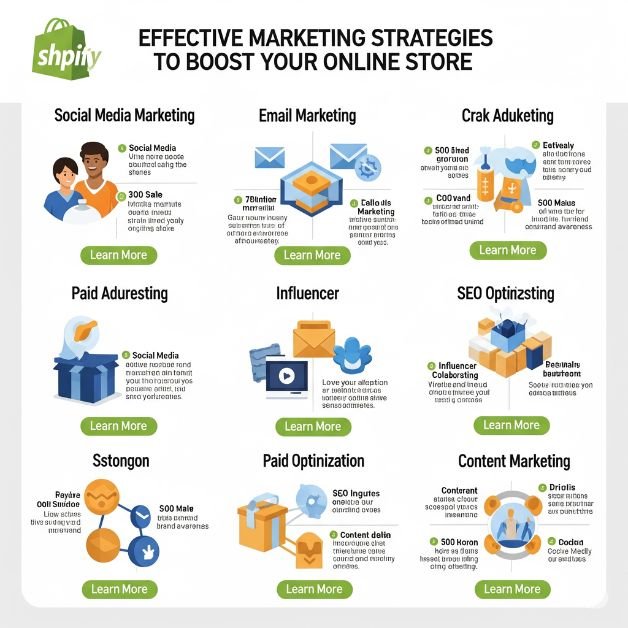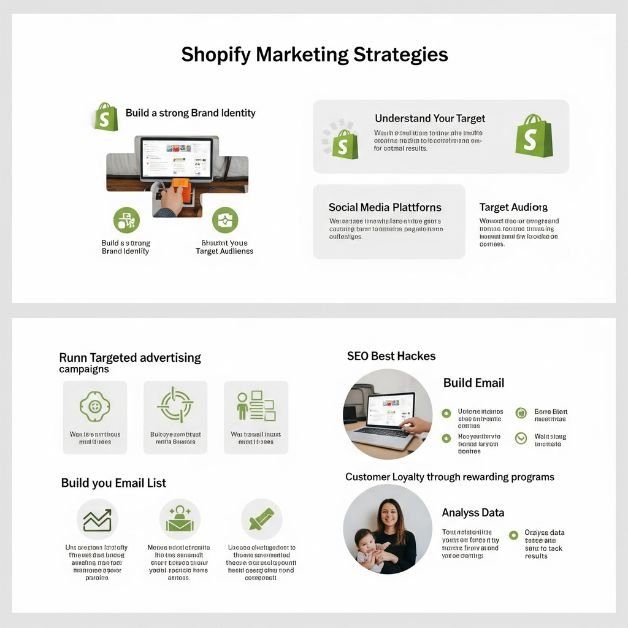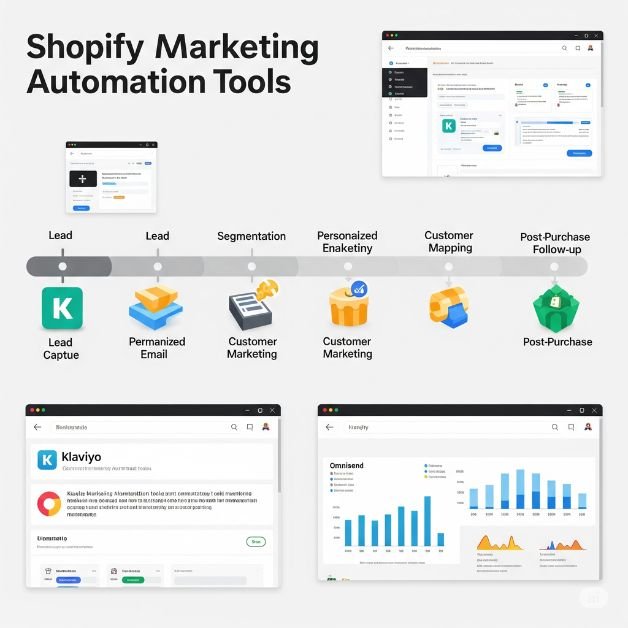
Discover the best Shopify marketing strategies to increase traffic, boost sales, and scale your eCommerce business in 2025. Learn proven tips for success.
Running an online store can be hard. You need to bring in visitors and turn them into buyers. I’ve been through it, and I know it can feel tough. But with the right Shopify marketing tools, it gets easier.
Shopify has great features, like product management and easy payment options. But to really grow, you need to use Shopify’s marketing tools. This guide will show you how to use SEO, social media, email marketing, and ads to boost your store. Let’s dive in and make your Shopify store better!
SEO stands for “Search Engine Optimization.” It’s the process of making your Shopify store easier for Google to find. When your store ranks higher, more people can find it. This leads to more visitors and, hopefully, more sales. I found that when I focused on SEO, my store’s traffic grew without spending extra money on ads. Shopify SEO helps you get free traffic from search engines, which can be a game-changer for your store. Read more details
Keyword research is the first step in SEO. It’s about figuring out what words people use to search for products like yours. I started by using free tools like Google Keyword Planner to find the right keywords for my store. The key is to pick keywords that match what your customers are looking for. Once you find the right keywords, you can use them in your product descriptions and other pages to help your store rank better. Keyword research is important because it helps your store show up in search results when people are looking for your products.
After finding the right keywords, it’s time to improve your product pages. These pages must be SEO-friendly to rank well on Google and turn visitors into buyers. Here’s what worked for me:
Shopify offers many apps to make SEO easier. I used a couple of these to help me optimize my store:

Social media is key for online stores. Instagram, Facebook, and Pinterest can help you grow your brand. When I first started, I realized just having a store wasn’t enough. I had to show it to the world. Instagram lets you share photos easily. Facebook helps you target the right people. Social media is a great tool to build your brand and get sales.
Linking Shopify with Instagram and Facebook is easy. Once you connect them, your customers can buy directly from these platforms. Here’s how:
Now, your customers can shop directly from Instagram and Facebook.
Having a good plan is important. I learned that posting often helps keep people interested. Aim to post three times a week. Share what your audience cares about. Show behind-the-scenes, product demos, and customer stories. This helps build trust. Interesting content makes people want to buy from you.
Product demos are great. People want to see how things work before buying. Behind-the-scenes posts work well too. Show how you make your products. This makes your brand feel real. Customer reviews help too. They show others that people trust your store.
Instagram and Facebook ads can help boost sales. The key is targeting the right people. First, choose your goal: traffic or sales. Then, target the right audience. You can choose by age, location, and interests. Keep your ads simple. Use clear images and a call to action. Test different ads to see what works.
When I first linked my store to Instagram and Facebook, my sales didn’t grow right away. But soon, I saw more visitors. I ran a sale on Instagram, tagged the product, and sales grew. Social media is a great way to get noticed and boost sales.

Email marketing is one of the best ways to grow your Shopify store. It’s cheap and works really well. I have seen how emails can help turn visitors into loyal buyers. With email, you can reach people who already know about your brand. Sending them the right offers can lead to more sales.
Email marketing helps you stay connected with customers and boost sales.
Setting up email campaigns on Shopify is easy. First, go to your “Marketing” section. Click on “Create Campaign” to pick the type of email you want. You can choose from things like newsletters or sale alerts. Then, choose who will get the email. Shopify offers templates to make creating your email fast and easy. Don’t forget to add a call-to-action, like “Shop Now” or “Claim Your Discount.”
With email campaigns, you can keep customers engaged and drive more sales.
Building a strong email list is key. You need people who care about your store. Shopify lets you add sign-up forms to your site. You can also offer discounts to encourage people to sign up. Once you have a list, segment it. Divide your list into groups like “first-time visitors” or “repeat buyers.” This way, you can send the right message to the right people.
Segmenting your list helps you send more relevant emails that will get better results.
Once your list is ready, it’s time to start sending emails. Here are some types of emails that work well:
Keep your emails clear, friendly, and to the point.
Shopify has apps that help with email marketing. I use two that make it easier for me:
Google Ads is a great way to bring targeted traffic to your Shopify store. It lets you show ads to people who are already looking for what you sell. When I started, I was unsure where to begin. But once I got the hang of it, I saw real growth. Google Ads allows you to target specific keywords. When someone searches for those keywords, your ad shows up.
Here’s how to set it up:
Google Ads can help you reach people who are ready to buy your products.
Picking the right keywords is key. I learned that long-tail keywords work best for me. These are specific phrases that cost less per click but can still bring in real buyers. Google gives you tools to help choose keywords that are relevant to your products. For ad formats, text ads are great for search. You can also try display ads for more exposure.
Pick keywords that match what your customers want. Keep your ad text clear and focused on your products.
Facebook Ads are a powerful tool for Shopify stores. Facebook lets you target people by age, interests, and even behaviors. I use Facebook Ads to keep my store in front of potential buyers. Whether people are just browsing or ready to buy, Facebook can show them your ad.
To set up Facebook Ads:
Facebook Ads help you target people who are most likely to buy your products.
One of the best things about Facebook Ads is the targeting. Facebook lets you create custom audiences. You can target people who visited your store but didn’t buy. I use this feature to show ads to these potential customers with a special offer.
Lookalike Audiences is another feature I love. It finds people who are similar to your best customers. This helps you reach new people who are more likely to buy.
When I first started using ads, I didn’t know how much to spend. The key is to start small. You can always increase your budget once you see results. Tracking ROI (Return on Investment) is important. You want to make sure your ad spend is bringing in more sales than it costs.
Monitor these key metrics:
Tracking your ad performance is important. These are the metrics I watch closely:
Influencer marketing is a great way to grow your Shopify store. When I first tried it, I wasn’t sure it would work. But it really helped. Influencers have loyal followers who trust their opinions. When they recommend your products, people are more likely to buy. This is a great way to get more traffic to your store.
Influencers bring traffic and build trust for your store.
Choosing the right influencer is key. It’s not about having the most followers. I found it’s better to work with influencers whose audience fits your brand. Look for influencers who share your values and engage with their followers. A smaller, more engaged audience can work better than a large one.
Choose influencers whose audience matches your brand and has good engagement.
It’s important to build a relationship with influencers. Long-term partnerships work better than just one post. Start by connecting with them. Offer free products or discounts in return. Be clear about your goals and work together. Building a strong relationship leads to better results.
Build a strong relationship by offering value and working together.
I worked with an influencer who had followers interested in eco-friendly products. I sent them a few items, and they posted about them. The post got a lot of attention. Traffic to my store grew, and I made more sales. Influencer marketing helped me reach the right people and boost my sales.
Influencer marketing helped me increase sales by reaching the right audience.

Running a Shopify store is a lot of work. You need to handle sales, orders, and marketing. I know it can feel overwhelming. That’s why I turned to automation. With Shopify, you can automate emails, ads, and social media. This saves time and lets you focus on what really matters—growing your business.
Automation makes your life easier. It helps you run your store smoothly without the extra effort.
Over the years, I’ve used a few great apps that made marketing easier. Here are my top picks:
These tools save me time and keep my store running smoothly.
Automation is a game-changer. Here’s how I use it:
By automating these tasks, I have more time to focus on my store’s growth.
Affiliate marketing is when someone promotes your products. They earn a commission for each sale they make. It helped my store grow. Affiliates already have a loyal audience. When they share your products, more people buy. It’s an easy way to boost sales. You only pay when you make a sale.
Affiliate marketing helps you reach new customers for a low cost.
Setting up an affiliate program on Shopify is easy. Here’s how I did it:
Now, I have affiliates who help promote my store and bring in more sales.
Managing affiliates is important. Here’s what I learned:
Good communication and rewards make strong partnerships.
Start with SEO and social media. These are easy to learn and effective. SEO helps people find your store. Social media helps you connect with customers and grow your brand. Focus on Instagram and Facebook for a good start.
To improve SEO, do keyword research. Find the words people use to search for your products. Use those words in your titles and descriptions. Make sure your page URLs are short and simple. Also, add alt text to your images.
Google Ads and Facebook Ads work well. Google Ads targets people searching for your products. Facebook Ads help you reach people based on age, interests, and location. Both are great ways to drive traffic and sales.
To link Shopify with social media, go to Sales Channels in Shopify. Choose Instagram and Facebook. Connect your accounts. Now you can tag products in posts and let customers shop directly.
Top tools are Klaviyo, Omnisend, and Kit. Klaviyo helps with automated emails. Omnisend combines email, SMS, and push notifications. Kit helps with ads and social media. These tools save time and grow your store.
Recap the Key Takeaways:
To grow your Shopify store, focus on key marketing strategies. Start with SEO to bring in free traffic. Use social media to show your brand to more people. Email marketing helps keep customers coming back. Use ads, influencer marketing, and automation tools to boost sales and make your work easier.
Call to Action:
Now, try these strategies for yourself! I’d love to hear how they work for you. Share your experiences in the comments below, and let’s help each other grow!
Learn more: Shopify Features
Contact us at the Consulting WP office nearest to you or submit a business inquiry online.
NextoBrand – Your trusted partner for web development, digital marketing, Shopify store design, and branding. Let's build something extraordinary together.
Don’t miss our future updates! Get Subscribed Today!
Copyright NEXTOBRAND © 2025 All Rights Reserved